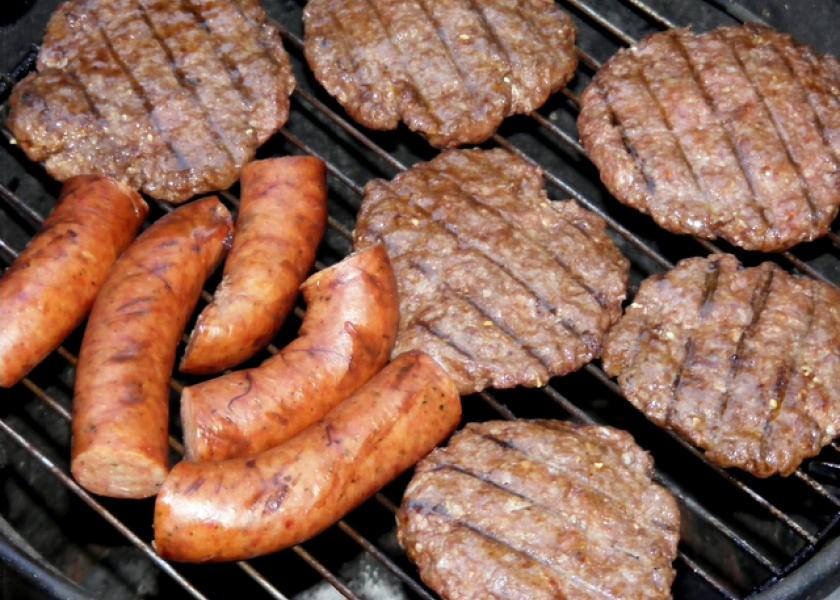Market Highlights: Dog Days of Summer Coming for Beef Prices

FED CATTLE: Fed cattle traded $2 to $3 lower than last week on a live basis. Prices on a live basis were mainly $106 to $108 while dressed prices were mainly $168 to $170.
The 5-area weighted average prices thru Thursday were $106.35 live, down $3.32 from last week and $169.99 dressed, down $6.84 from a week ago. A year ago prices were $118.65 live and $189.95 dressed.
Since the second week of April, the June live cattle contract has traded in a $10 range from $101 to $111 while the cash market has traded in a $19 range from $106 to $125. During this same time period, the market has moved from a positive $20 basis on live cattle to essentially an even basis this week.
The market environment has made it difficult to successfully hedge cattle sales to capitalize on strong prices experienced in the spring. There have been a few opportunities to benefit from hedging strategies, but the losses in the cash market have been much larger than the gains in the futures market which means producers would have had to hold some speculative positions to negate the total loss.
BEEF CUTOUT: At midday Friday, the Choice cutout was $217.11 down $0.08 from Thursday and down $3.95 from last Friday. The Select cutout was $199.83 down $0.83 from Thursday and down $4.10 from last Friday. The Choice Select spread was $13.33 compared to $13.18 a week ago.
The Choice cutout peaked just under $232 in the middle of May and has declined nearly $15 per hundredweight in a matter of six weeks.
The apex in the beef cutout came just prior to the Memorial weekend holiday and was closely followed by Father’s Day which continued supporting the market. Independence Day also tends to support the beef market as a grilling holiday, but the focus on middle meats declines slightly as many consumers focus on hotdogs and hamburgers.
There is some skepticism of beef clearance for Independence Day given that it falls in the middle of the week, but most consumers will likely proceed as usual with normal Fourth of July activities. Looking deeper into the summer months, the dog days of summer will hamper cutout prices as will a strong beef supply.
Following the restocking of meat counters next week, packers will turn their attention to Labor Day which is more than two months down the road. Could Choice beef test the $200 mark? It is more likely than not.
OUTLOOK: Summer heat is beginning to put pressure on calf prices while strong cattle on feed numbers are placing pressure on yearling cattle prices. Using Tennessee weekly auction averages, 500 to 600 pound steers traded more than $5 lower than the same week one year ago while 700 to 800 pound steers were $8 lower compared to the same week last year. Considering 500 to 600 pound steer prices, prices in 2018 were higher than 2017 prices from January through April.
In fact, nine of those weeks saw 2018 prices exceed year ago prices by $20 or more which amounts to at least $100 per head. However, since the beginning of May, the tide has turned to lower prices in 2018 compared to 2017.
There are no cow-calf producers that want to hear that prices are likely to continue to decline but lower prices are expected for lightweight calves moving through the summer and fall months.
Considering seasonal price trends from this point moving into October and November and considering the average decline from the price peak in the spring to the fall months for 500 to 600 pound steers, prices will likely bottom out in the $135 to $141 price range which puts prices steady to $5 per hundredweight lower than fall 2017.
This means there will continue to be several profitable cow-calf producers, but it also means there will be several producers who are losing money.
A similar story can be told for 700 to 800 pound steers as 2018 weekly average prices exceeded 2017 prices through the middle of April and then moved lower than year ago prices when compared to the same week in 2017.
The difference in yearling cattle prices and calf prices is yearling cattle prices generally strengthen in the summer, but this may be a difficult task to achieve due to strong cattle on feed numbers. Moving from the end of June into October and November, producers should be prepared for feeder cattle prices to decline 3 to 5 percent.
ASK ANDREW, TN THINK TANK: A question was asked this week concerning marketing dairy calves and the need for identification in those animals. The answer to this question goes back a few years, but it could be an important reminder to those in the livestock business. In 2013, the Animals Disease Traceability Rule went into effect and it requires livestock moving across state lines to be officially identified and accompanied by an interstate certificate of veterinary inspection. This rule includes cattle, bison, equine, poultry, sheep, goats, swine and captive cervids (deer, elk, etc.) As it relates to cattle, identification is required for sexually intact cattle 18 months of age and older, all female dairy cattle and all dairy males. Cattle not requiring identification include, beef cattle under 18 months of age, cattle going directly to slaughter, and cattle going to a premise where they can be officially identified.
Please send questions and comments to agriff14@utk.edu or send a letter to Andrew P. Griffith, University of Tennessee, 314B Morgan Hall, 2621 Morgan Circle, Knoxville, TN 37996.
FRIDAY’S FUTURES MARKET CLOSING PRICES: Friday’s closing prices were as follows: Live/fed cattle –August $106.73 +3.00; October $110.03 +3.00; December $113.70 +2.38; Feeder cattle –August $151.33 +4.50; September $150.95 +3.58; October $150.08 +2.80; November $149.75 +2.53; July corn closed at $3.50 up $0.05 from Thursday.











